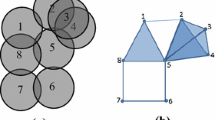Abstract
The heterogeneity of sensing devices has to be taken into account for increasing the network performance and lifetime. This paper presents a study for the sensor relocation problem based on the heterogeneity point of view. A novel approach named Best Fit Relocation Approach, BFRA, is proposed for heterogeneous sensors in order to maximize the coverage of the monitored field and guarantee the connectivity of the deployed sensors. This approach proposes new computational geometry algorithms with perfect complexity to be exploited in small and large-scale sensor networks. A simulation tool is proposed to perform a set of experiments to evaluate the proposed algorithms for different sensor characteristics taking into consideration the curly of field boundaries and the presence of obstacles. Simulation results show that near-optimal coverage performance could be achieved in much less both running time and average moving distance.
Similar content being viewed by others
References
Akyildiz I., Su W., Sankarasubramaniam Y., Cayirci E. (2002) A survey on sensor networks. IEEE Communications Magazine 40(8): 102–116
Sohraby K., Minoli D., Zntai T. (2007) Wireless sensor networks: Technology, protocols, and applications. John Wiley and Sons Inc., Hoboken, New Jersey
Burrell J., Brooke T., Beckwith R. (2004) Vineyard computing: Sensor networks in agricultural production. IEEE Pervasive Computing 3(1): 38–45
Hussain S., Erdogen S., Park J. (2009) Monitoring user activities in smart home environments. Information Systems Frontiers Springer 11(5): 539–549
Kewei, S., Weisong, S., & Watkins, O. (2006). Using wireless sensor networks for fire rescue applications: Requirements and challenges. IEEE International conference on electro/information technology, pp. 239–244.
Ramadan, R., & Abdel-Mageid, S. (2010). Efficient deployment of connected sensing devices using circle packing algorithms. IEEE international conference on autonomous and intelligent systems (AIS).
Fan, J., & Parish, D. (2008). Optimization of wireless sensor networks design using a genetic algorithm. Parallel and distributed computing and systems proceedings, ACTA Press.
Ramadan, R., Abdelghany, K., & El-Rewini, H. (2007). Optimal and approximate approaches for deployment of heterogonous sensing devices. EURASIP Journal on Wireless Communications and Networking, 2007. doi:10.1155/2007/54731.
Wang, G., Cao, G., & LaPorta, T. (2004). Movement-assisted sensor deployment. In Proceedings IEEE INFOCOM, pp. 2469–2479.
Wang G., Cao G., LaPorta T. (2007) Bidding protocols for deploying mobile sensors. IEEE Transactions on Mobile Computing 6(5): 515–528
Ma M., Yang Y. (2007) Adaptive triangular deployment algorithm for unattended mobile sensor networks. IEEE Transactions on Computers 56(7): 946–958
Howard, A., Mataric, M. J., & Sukhatme, G. S. (2002). Mobile sensor network deployment using potential fields: A distributed scalable solution to the area coverage problem. In Proceedings of the 6th international conference on distributed autonomous robotic systems (DARS02) (pp. 299–308). Fukuoka, Japan.
Zou, Y., & Chakrabarty, K. (2003). Sensor deployment and target localizations based on virtual forces. In Proceedings of IEEE Infocom.
Abdel-Mageid, S., & Ramadan, R. (2010). Efficient deployment algorithms for mobile sensor networks. IEEE international conference on autonomous and intelligent systems (AIS).
Niculescu, D., & Nath, B. (2003). Ad Hoc positioning systems (APS) Using AoA. In Proceedings IEEE INFOCOM.
Savvides, A., Han, C., & Strivastava, M. B. (2001). Dynamic fine-grained localization in Ad-Hoc networks of sensors. In Proceedings ACM MobiCom.
de Berg M., van Kreveld M., Overmars M., Schwarzkopf O. (1997) Computational geometry algorithms and applications. Springer-Verlag, second, Revised Edn. (2000) Berlin
Cormen T., Leiserson C., Rivest R. (1990) Introduction to algorithms. McGraw-Hill, New York
Wireless sensing networks. (2004). http://wins.rsc.rockwell.com.
Berkeley sensor and actuator center. (2004). http://www.bsac.eecs.berkeley.edu.
Rudolph G. (1997) How mutation and selection solve long-path problems in polynomial expected time. Evolutionary Computation 4(2): 195–205
Jansen T., Wegener I. (2001) Evolutionary algorithms—how to cope with plateaus of constant fitness and when to reject strings of the same fitness. IEEE Transactions on Evolutionary Computation 5: 589–599
Neumann, F., & Witt, C. (2006). Runtime analysis of a simple ant colony optimization algorithm. In Proceedings of the 17th international symposium on algorithms and computation (ISAAC ‘06), 4288 (pp. 618–627). Springer.
Author information
Authors and Affiliations
Corresponding author
Rights and permissions
About this article
Cite this article
Mageid, S.A., Zaki, M. A Best Fit Relocation Approach for Heterogeneous Sensor Networks. Wireless Pers Commun 65, 733–751 (2012). https://doi.org/10.1007/s11277-011-0282-y
Published:
Issue Date:
DOI: https://doi.org/10.1007/s11277-011-0282-y




